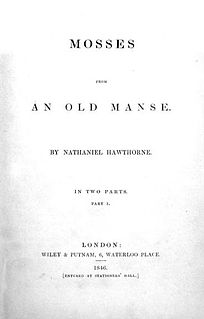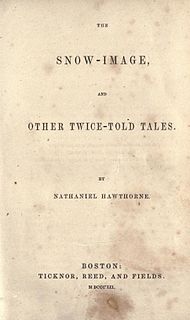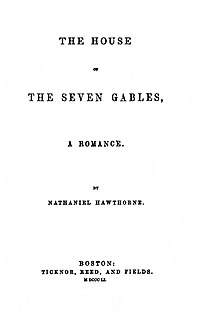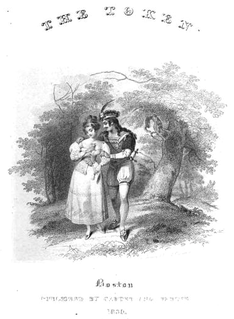
Nathaniel Hawthorne was an American novelist, dark romantic, and short story writer. His works often focus on history, morality, and religion.

Rose Hawthorne Lathrop, also known as Mother Mary Alphonsa, was an American writer and religious leader. She was a Catholic religious sister, social worker, and foundress of the Dominican Sisters of Hawthorne.

The Marble Faun: Or, The Romance of Monte Beni, also known by the British title Transformation, was the last of the four major romances by Nathaniel Hawthorne, and was published in 1860. The Marble Faun, written on the eve of the American Civil War, is set in a fantastical Italy. The romance mixes elements of a fable, pastoral, gothic novel, and travel guide.

Sophia Amelia Peabody Hawthorne was an American painter and illustrator as well as the wife of author Nathaniel Hawthorne. She also published her journals and various articles.

The House of the Seven Gables is a 1668 colonial mansion in Salem, Massachusetts, named for its gables. It was made famous by Nathaniel Hawthorne's 1851 novel The House of the Seven Gables. The house is now a non-profit museum, with an admission fee charged for tours, as well as an active settlement house with programs for children. It was built for Captain John Turner by Samuel Wardwell and stayed with the family for three generations.

Mosses from an Old Manse is a short story collection by Nathaniel Hawthorne, first published in 1846.

The Snow-Image, and Other Twice-Told Tales is a collection of short stories by American author Nathaniel Hawthorne. Released in late 1851 with a copyright of 1852, it is the final collection of tales by Hawthorne published in his lifetime.

Twice-Told Tales is a short story collection in two volumes by Nathaniel Hawthorne. The first volume was published in the spring of 1837 and the second in 1842. The stories had all been previously published in magazines and annuals, hence the name.

The Nathaniel Hawthorne Birthplace is the home where American author Nathaniel Hawthorne was born. It is located at 27 Hardy Street but accessible through 54 Turner Street, Salem, Massachusetts. The house is now a nonprofit museum along with the House of the Seven Gables immediately adjacent; an admission fee is charged.

Julian Hawthorne was an American writer and journalist, the son of novelist Nathaniel Hawthorne and Sophia Peabody. He wrote numerous poems, novels, short stories, mysteries and detective fiction, essays, travel books, biographies, and histories.

The House of the Seven Gables: A Romance is a Gothic novel written beginning in mid-1850 by American author Nathaniel Hawthorne and published in April 1851 by Ticknor and Fields of Boston. The novel follows a New England family and their ancestral home. In the book, Hawthorne explores themes of guilt, retribution, and atonement, and colors the tale with suggestions of the supernatural and witchcraft. The setting for the book was inspired by the Turner-Ingersoll Mansion, a gabled house in Salem, Massachusetts, belonging to Hawthorne's cousin Susanna Ingersoll, as well as ancestors of Hawthorne who had played a part in the Salem Witch Trials of 1692. The book was well received upon publication and later had a strong influence on the work of H. P. Lovecraft. The House of the Seven Gables has been adapted several times to film and television.

A Wonder-Book for Girls and Boys (1851) is a children's book by American author Nathaniel Hawthorne in which he retells several Greek myths. It was followed by a sequel, Tanglewood Tales.
"The Ambitious Guest" is a short story by Nathaniel Hawthorne. First published in The New-England Magazine in June 1835, it was republished in the second volume of Twice-Told Tales in 1841.

"Roger Malvin's Burial" is a short story by American author Nathaniel Hawthorne. It was first published anonymously in 1832 before its inclusion in the 1846 collection Mosses from an Old Manse. The tale concerns two fictional colonial survivors returning home after the historical battle known as Battle of Pequawket.

Ticknor and Fields was an American publishing company based in Boston, Massachusetts.

The Token (1829–1842) was an annual, illustrated gift book, containing stories, poems and other light and entertaining reading. In 1833, it became The Token and Atlantic Souvenir.

"Chiefly About War Matters", originally credited "by a Peaceable Man", is an 1862 essay by American author Nathaniel Hawthorne. The essay was inspired by the author's traveling during the American Civil War to experience more of the firsthand. Upon its publication, it was controversial for its somewhat pro-southern stance and antiwar sentiments. Hawthorne was also chastised for his unflattering descriptions of American president Abraham Lincoln.

"Hawthorne and His Mosses" (1850) is an essay and critical review by Herman Melville of the short story collection Mosses from an Old Manse written by Nathaniel Hawthorne in 1846. Published pseudonymously by "a Virginian spending July in Vermont", it appeared in The Literary World magazine in two issues: August 17 and August 24, 1850. It has been called the "most famous literary manifesto of the American nineteenth century."
"The Celestial Railroad" is short story by American author Nathaniel Hawthorne. In the allegorical tale, Hawthorne parodies the seventeenth-century book The Pilgrim's Progress by John Bunyan, which portrays a Christian's spiritual "journey" through life. The story satirizes contemporary religious movements, especially transcendentalism.

"The Artist of the Beautiful" is a short story by the American writer, Nathaniel Hawthorne. The story was first published in 1844 and was included two years later in the collection Mosses from an Old Manse published by Wiley & Putnam.


















